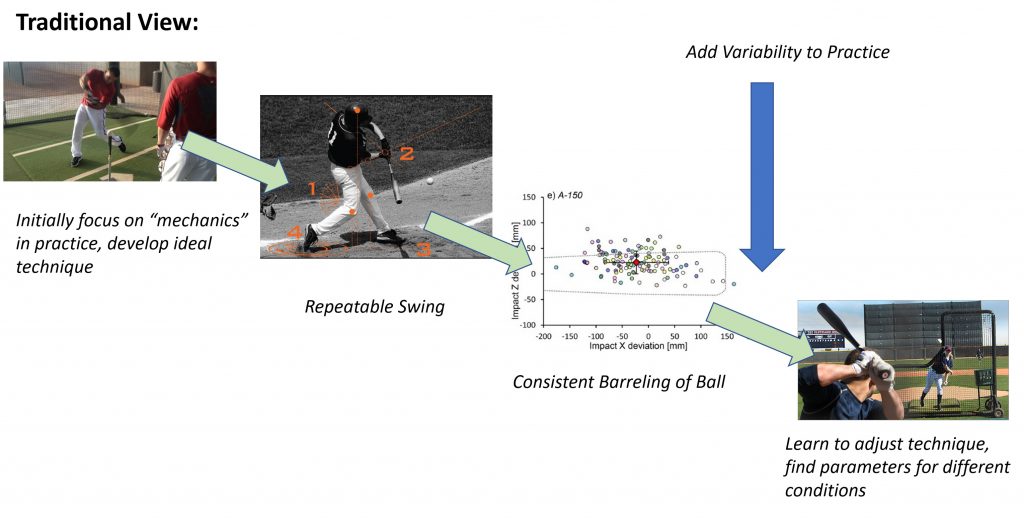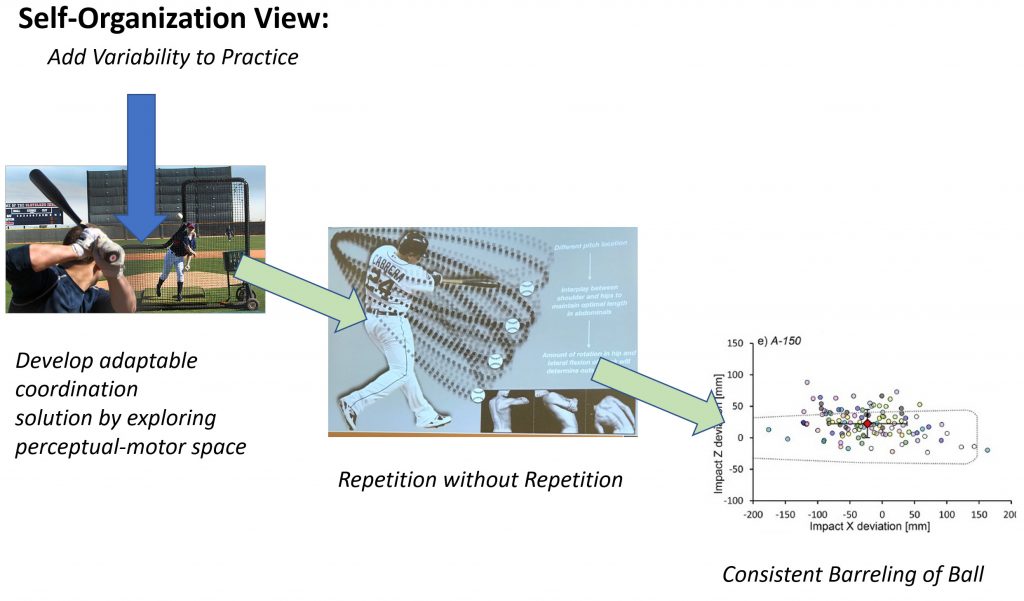Some degree of variability in practice conditions is good! I don’t think that’s too controversial of an opinion. Although we may quibble over things like how applicable studies comparing blocked vs random practice are to real sports skills, I think almost all researchers and coaches would agree with my first statement. Here, I want to move beyond the “if we should” to the “why”, “when” and “how”. Following up on my first post directly contrasting Prescriptive Instruction and Self-Organization and the associated podcast episode, I want to examine the ways in which the answers to the “why”, “when” and “how” of variability differ for these two approaches to skill acquisition. The main point I want to try to make is that if you want to incorporate variability in practice in the most effective way, you need to ask “why” you are doing it (i.e., you need to align your practice design with a theoretical approach).
The Traditional, Prescriptive Instruction Approach
Key Assumptions: Skilled movement involves an ideal technique that is executed by a central controller in the brain (internal/mental model, motor program, schema, representation) which issues top-down commands to the muscles.
A good way to think about this issue is how the two different approaches relate practice variability to movement variability to outcome variability. As shown in the figure below for baseball batting, in the traditional approach, it is proposed that low outcome variability (consistently hitting the ball in the middle of the barrel of the bat – which we want no matter what approach we take to coaching!), is achieved through low movement variability (having a repeatable swing). So, repetition (of outcome) through repetition (of movement). To achieve this we typically start with low variability in practice conditions (e.g. hitting of a tee as shown in the figure) because we want the performer to learn the “correct” technique first before they plug it into more variable game conditions.

Therefore, the purpose of adding variability (later in the skill acquisition process) is to allow the performer to develop adjustability of the ideal technique to specific variations in environmental conditions that will occur in competition. For example, to keep the ideal swing for both fast and slow pitches, to have a “correct” golf swing both on flat ground or a downhill slope, or to execute an accurate soccer pass from short and long distances. This is the “why”.
As far as the “when” goes, if we follow this approach we would want to add higher variability relatively late in the skill acquisition process because we need the basic technique already developed first. That is why we start training with athletes dribbling around cones, hitting off tees, and always practicing golf swings on flat ground. We are purposely reducing the variability and removing things like decision making because the internal model/motor program is best established through low variability, repeatable conditions. There is a lot of research evidence consistent with this idea. For example, we know that a basic level of performance (under the same conditions) is acquired faster in blocked as compared to random conditions – it is only later in retention and transfer tests that random becomes superior. Another example, is the Lee et al (2014) study I talked about in Episode 190. In this study looking at training tennis strokes, the group that had lower variability practice not surprisingly scored higher on ratings of technical proficiency made by a coach after training as compared to a high variability training group. If you want a performer to develop one ideal technique, low variability is the way to start.
Now, what about the “how”? Remember the goal of adding variability here is to get the performer to elaborate on their existing movement solution so it can be maintained and be effective under different conditions that might occur in real competition. This means we should ideally be doing three things in terms of how variability is used:
1) I know this a counter-intuitive way to put it, but we want representative variability in practice conditions here. That is, the things we vary in practice (speed, distance, spacing of players) should be things that will vary in the game. It makes no sense at all to add something that would never occur (e.g. a larger than normal ball or closing one eye). Why would we want our solution to be able to adjust to such things if they are going to never happen in a game?
2)The coach should give corrective feedback about any deviations in technique that occur in response to the new variations in conditions. This could come in the form of cues to get the performer back to the ideal movement they developed under low variability conditions (“remember you need to keep your knees bent”) or in the form of an instruction that tells the performer specifically how the movement solution needs to be adjusted to a specific variation (e.g. “when hitting on a downhill position the ball back in your stance..”)
3)Ideally, there should be a progressive and systematic increase in the variability of practice – what is sometimes called serial practice. So, we want to move from always practicing a golf swing on flat groud (constant) to mixing in different slopes (variable). And we would likely do this in a monotonic manner (i.e. beginning with a small slope than progressively getting steeper). There is some good evidence supporting the effectiveness of this progression from blocked to random (or constant to variable) in terms of contextual interference (Porter & Beckman, 2016).
So, in nutshell, in this approach the goal is: repetition with repetition despite variation.
The Self-Organization Approach
Key Assumptions: Skilled movement involves establishing a relationship between the performer and their environment (an information-movement coupling). This occurs through a process of self-organization (not a central controller) in which a solution emerges through an interaction between the ever-changing task, individual and environmental constraints.
Referring again to the relationship between the different types of variability, as shown in the figure below, in this approach it is proposed that low outcome variability REQUIRES a significant degree of movement variability (because the internal and external conditions are dynamic and changing). So, repetition (of outcome) without repetition (of movement). To achieve this, we want to introduce variability right at the beginning of training to encourage exploration of the perceptual-motor landscape and learning to solve movement problems for the particular sport in question. It is proposed here, that successful performance in the real, dynamic sporting environment requires the use of different (not one ideal) movement solutions (i.e., degeneracy) because the constraints are ever-changing.

The purpose of adding variability (right at the start of training) in this approach is to encourage exploration of the perceptual-motor landscape so that the performer will educate their attention to the specifying information and the system will be able to self-assemble coordination solutions. Variability’s purpose is to develop adaptability in being able to solve movement problems (or as Keith Davids called it “learning to learn to move”) not to develop adjustability of an already developed technique. That is the “why”.
In terms of “when”, we want a relatively high degree of variability from the start. So instead of tees, cones, and flat ground we want thrown balls, interactions with opponents and changing ground conditions. But, of course, we do need to scale the amount of variability appropriately for the skill level and age of the performer. Because when we start learning a new skill and/or are younger we will likely have a lot of inherent movement variability we need less of it in the practice conditions. This has been used an explanation of why some studies show positive benefits of differential learning and others don’t (discussed in Episode 162 of the podcast). This effect can also be seen in the benefits of scaling equipment appropriately for children. For example, using a lower compression ball, which will reduce the variability in conditions compared to a regulation ball, seems to facilitate learning by allowing children to effectively explore the solution space and develop functional variability.
Now what about “how”? If our goal is to develop a performer that has different, adaptable movement solutions to achieve the same outcome (degeneracy) we likely want to be doing three things in terms of how variability is used:
1)In this approach, unrepresentative variability (i.e., variations in the practice conditions that would never occur in actual competition) are not only OK, they are desirable! Remember we are trying to teach the performer to problem solve (i.e., self-organize into a coordination solution that meets the goal in face of the particular constraints they face) and to “learn to learn to move”. We are not trying to teach them to come up with specific adjustments of solutions to specific variations of conditions they might face in the game. Using different sized balls, weird body postures and closing one or the other eye as is used in differential learning are all good here because they all require the performer to solve a movement problem.
2)Obviously since there is no ideal technique there is nothing for the coach to correct when the performer establishes a coordination solution under variable conditions. However, the coach can and should step in if the performer doesn’t seem to be finding a solution and/or they converge on a maladaptive one (e.g., one that is likely to lead to injury in the long term). I discussed what might be done in this situation in my previous post about using a connection ball in baseball pitching.
3)A systematic increase in the variability of practice conditions could be used but there is no real a priori reason it is necessary. In terms of differential learning, as I discussed in Episode 162, serial or ordered variations in conditions are just another of many possible random sequences of conditions. And, of course, in the self-organization approach learning is nonlinear so we may need to actually decrease the amount of variability at some points in the skill acquisition process.
In sum, in this approach the goal is: repetition without repetition because of variation.
Summary
Although variability of practice conditions is beneficial in both theoretical approaches, the “why”, “when” and “how” are very different. Maybe some coaches out there can combine the two ways of using variability but to me it just doesn’t seem logical. Why would you want to spend hours getting a performer to execute a movement in a certain way only to let them substantially deviate from that technique in a differential learning session the next day? There will be an irresistible urge to step in and correct. Personally, I have seen this many times. A coach will try something like small sided games or a constraint manipulation because they have heard about it but not really thought about the “why”. So they jump in a begin giving instructions quickly when they don’t see what they want. In my opinion, practice design will be more effective if you think about the “why” and the associated theoretical approach.
